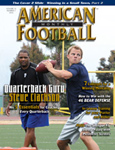Article CategoriesAFM Magazine
|
In-Season Speed Training - Good News, Bad Newsby: Dale BaskettFootball Speed Specialist © More from this issue Summer is over and now it’s time to turn on the lights and begin with weekly competition. Speed and strength should be at their peak levels coming into the fall season. The months of hard work with zero competition are over and it’s time to benefit from the fruits of your labor. Speed should certainly be at the razor’s edge coming in. Technical Speed Requirements Technique is the hallmark of elite football speed and control for an athlete. This is due to the fact....The full article can only be seen by subscribers.
|
|
|||||||
| HOME |
MAGAZINE |
SUBSCRIBE | ONLINE COLUMNISTS | COACHING VIDEOS |
Copyright 2025, AmericanFootballMonthly.com
All Rights Reserved





